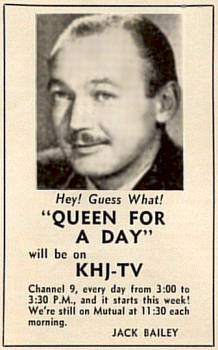Metropolitan News-Enterprise
Wednesday, November 27,
2002
Page 22
REMINISCING (Column)
Channel 9: Yawwwwn.
By ROGER M. GRACE
Up until the 1990s, L.A. had four independent
stations on the VHF band: KTLA, Channel 5; KHJ-TV (previously KFI-TV), Channel
9; KTTV, Channel 11; and KCOP (originally KLAC), Channel 13.
Three of those channels have aired retrospective
specials, telling of their broadcasting feats through the decades: Channels 5,
11, and 13.
Why no retrospective on Channel 9? Simple. The history
of that channel is one of mediocrity and scandal.
The scandal, as you probably recall, entailed
fraudulent billing practices and bribery. It culminated in RKO General, owner
of KHJ-TV, losing its licenses to operate TV and radio stations. I’ll go into
that saga next week.
As to mediocrity: The station has been owned by
various entities, but through its 54-year history, none of those owners made a
real commitment to it. It has, consistently, been the ho-hum place on the TV
dial.
That’s not to say that Channel 9 was a total loss. Those of us who grew up in
the 1950s do remember with fondness “Engineer Bill” Stulla, who emceed cartoons.
He was so good-natured he can probably be forgiven for his “red light, green
light” ruse to trick kiddies, in the guise of a game, into drinking milk.
There was the “Channel 9 Movie Theater,” subsequently dubbed
“Million Dollar Movie,” which featured old flicks, mostly produced by the
station’s owner, RKO—such as the original 1933 version of “King Kong”—aired
five nights in succession. However, the RKO movies, in general, did not rival
the quality of the MGM and Paramount movies being shown on Channel 11.
During a period from 1954-55, it aired some of the Du
Mont shows, as an affiliate.
“Queen for a Day,” a radio show on Mutual since 1945,
was broadcast nationally from the studio at 1313
North Vine Street in Hollywood, and
heard locally on KHJ-AM. KHJ-TV, headquartered at that location, televised the
show from Jan. 14, 1952 until it went on the NBC television network Jan. 3,
1956.
One
distinction KHJ-TV had was its broadcasts of "Queen for
a Day," heard coast-to-coast as a Mutual Broadcasting System radio show.
The erstwhile Don Lee radio network, on the West Coast, had
been linked since the mid-1930s to the national Mutual network,
and Don Lee and Mutual came to share a Hollywood studio on Vine
Street. When RKO purchased Don Lee assets from the estate of
Thomas Lee in the early 1950s, and also bought Channel 9 from
Earle C. Anthony, the result was KHJ-TV, Channel 9, broadcasting
from the same facility as Mutual -- that is, the facility from
which "Queen for a Day" was aired nationally on radio.
It was natural for KHJ to provide a local TV version of the show.
This was not a new idea, however. In the late 1940s, the Don
Lee television station in Los Angeles, KTSL, had simulcast "Queen
for a Day."
|

|
A trademark of KHJ was the mellow voice of station
announcer Ted Meyers (who now and then served as a newsman). Elvira introduced
horror movies; Regis Philbin was a co-host on a short-lived morning show there
in the early 1970s; Jerry Dunphy spent his latter years as a news anchor on
that station.
There were sports events. Network re-runs. Infomercials.
That’s about it. Not enough to warrant a
retrospective.
Why did KHJ align itself in 1954 with Du Mont, a moribund network? My theory is that it
was to add an air of credibility to a lackluster station. “Du Mont” was the
name of a known national network. KHJ picked up but a few shows from it, yet
flashed Du Mont’s logo on the screen and intoned its name in station
identifications and included the logo in newspaper and TV Guide ads. It even
did so for a time after it stopped airing Du Mont programs.
In June 1955, its sole Du Mont show was “Chance of a Lifetime.” As of
July, it was Du Mont-less. Nonetheless, it was listed in TV Guide as a Du Mont
station up until December 1955.
The need KHJ perceived to bolster its image through association is seen
in the fact that it had, up until the very day it hooked up with Du Mont,
prominently referred to itself as L.A.’s “Don Lee station.” However, as
previously observed here, neither Don Lee—who founded KTSL, the station that is
now KCBS, and amassed a network of west coast radio stations—nor his son,
Thomas S. Lee, who took over when his father died in 1934, had been connected
with Channel 9. General Tire and Rubber Company, through its subsidiary General
Teleradio, in 1951 purchased the assets of the estate of Thomas Lee; the name
“Don Lee Television” was one of the assets; General Tire later bought KHJ, and
invoked the recognized name of Don Lee. It even referred to its news program as
“Don Lee News.”
General Tire in 1955 purchased RKO Radio Pictures, selling the movie
lot to Desilu, but retaining the film library for use on KHJ and on its New
York station, WOR-TV. In 1958, it began referring to its TV stations as those
of “RKO General.”
Channel 9 never set trends, never innovated, never really put forth effort. If a
major news event occurred, it was not KHJ that was there to cover it.
Through the years, it provided picture and sound, and
sold time to advertisers. It was just there. Other stations can recount
triumphs. Channel 9 can’t.
Maybe that will change, given the purchase of Channel
9 (now KCAL) by CBS last May.
Maybe.
Copyright 2002, Metropolitan News Company
MetNews Main Page Reminiscing Columns
